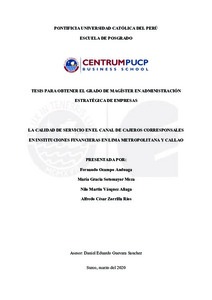| dc.contributor.advisor | Guevara Sánchez, Daniel Eduardo | |
| dc.contributor.author | Ocampo Anduaga, Fernando | |
| dc.contributor.author | Sotomayor Meza, María Gracia | |
| dc.contributor.author | Vásquez Aliaga, Nilo Martín | |
| dc.contributor.author | Zorrilla Ríos, Alfredo César | |
| dc.date.accessioned | 2020-06-30T20:44:08Z | |
| dc.date.available | 2020-06-30T20:44:08Z | |
| dc.date.created | 2020-03 | |
| dc.date.issued | 2020-06-30 | |
| dc.identifier.uri | http://hdl.handle.net/20.500.12404/16574 | |
| dc.description.abstract | Los cajeros corresponsales, entendido como un tercero fuera del sistema financiero que presta
ciertos servicios bancarios (SBS, 2008), es uno de los canales alineados a la Estrategia
Nacional de Inclusión Financiera – ENIF, la cual cuenta con los siguientes tres pilares:
acceso, uso y calidad de los servicios financieros (MEF, 2015). Este canal, reconocido por su
costo eficiencia (BCP, 2018), ha tenido a nivel nacional un importante crecimiento en la
última década (ASBANC, 2017). Este canal viene generando una creciente atención, no
obstante, surge una problemática ante la falta de estudios publicados que evalúen su calidad
de servicio. Por tal motivo, el presente estudio utilizará la herramienta SERVQUAL para
medir la calidad del servicio en cajeros corresponsales de determinadas zonas geográficas de
Lima Metropolitana y la Provincia Callao denominadas “periféricas”.
Este instrumento mide la calidad de servicio a través de cinco dimensiones
(tangibilidad, confiabilidad, capacidad de respuesta, seguridad y empatía), contraponiendo las
expectativas de los usuarios con sus percepciones (Parasuraman, 1988). El estudio se realizó
adaptando el cuestionario del instrumento para ser aplicado a 384 personas de 18 a 64 años,
que califican como usuarios recurrentes de este servicio. Los resultados obtenidos validaron
la capacidad del instrumento para medir la calidad del servicio en este canal, demostrándose
que existe un impacto de cada una de las dimensiones. Las mayores brechas entre
expectativas y percepciones de los usuarios fueron encontradas en empatía, capacidad de
respuesta y seguridad (en ese orden). Con estos hallazgos se trabajó en los lineamientos de
tres planes de acción para reducir las mayores brechas identificadas, siendo la actividad más
importante el desarrollo de una campaña de capacitación dirigida a las personas que atienden
a los cajeros corresponsales. Con esto, se pretende fortalecer la relación existente entre las
entidades bancarias y los establecimientos comerciales que brindan este servicio, para reducir
las brechas de la dimensión empatía, mejorando la calidad del servicio. | es_ES |
| dc.description.abstract | The correspondent banking agent, understood as a third party outside the financial system that
provides certain banking services (SBS, 2008), is one of the channels aligned to the National
Financial Inclusion Strategy – ENIF (acronym in Spanish), which has three pillars: access, use
and quality of financial services (MEF, 2015). This channel, recognized for its cost efficiency
(BCP, 2018), has had an important growth nationwide in the last decade (ASBANC, 2017).
This channel has been generating increasing attention; however, there is a research gap due to
the lack of published studies that have assessed its quality of service. For this reason, the present
study will use the SERVQUAL tool to measure the quality of service in correspondent banking
agent of certain geographical areas of Metropolitan Lima and the Province of Callao, called as
“peripherals”.
This instrument measures the quality of service through five dimensions (tangibility,
assurance, tangible, empathy and responsiveness), contrasting user expectations with their
perceptions (Parasuraman, 1988). The study was carried out by adapting the questionnaire of
the instrument, to be applied to 384 individuals between 18 to 64 years old, who qualify as
recurring users of this service. The results obtained validate the suitability of the instrument to
measure the quality of the service in this channel, showing that there is an impact in each of
the dimensions. The largest gaps between user’s expectations and perceptions were found in
empathy, responsiveness and assurance (in that order). These results made possible to build
three action plans, to reduce the largest gaps found, been the most important activity a training
for the workers at the correspondent banking agents. This is intended to strengthen the
relationship between banks and the stores that provide the service, to reduce the gaps in the
empathy dimension, improving the quality of service. | es_ES |
| dc.language.iso | spa | es_ES |
| dc.publisher | Pontificia Universidad Católica del Perú | es_ES |
| dc.rights | info:eu-repo/semantics/openAccess | es_ES |
| dc.rights.uri | http://creativecommons.org/licenses/by-nc-nd/2.5/pe/ | * |
| dc.subject | Cajeros corresponsales--Perú | es_ES |
| dc.subject | Calidad de servicios financieros | es_ES |
| dc.subject | Sector financiero--Perú | es_ES |
| dc.title | La calidad de servicio en el canal de cajeros corresponsales en instituciones financieras en Lima Metropolitana y Callao | es_ES |
| dc.type | info:eu-repo/semantics/masterThesis | es_ES |
| thesis.degree.name | Maestro en Administración Estratégica de Empresas | es_ES |
| thesis.degree.level | Maestría | es_ES |
| thesis.degree.grantor | Pontificia Universidad Católica del Perú. CENTRUM | es_ES |
| thesis.degree.discipline | Administración Estratégica de Empresas | es_ES |
| renati.advisor.dni | 09412483 | |
| renati.advisor.orcid | https://orcid.org/0000-0002-6374-8062 | es_ES |
| renati.author.dni | 42973480 | |
| renati.author.dni | 43304008 | |
| renati.author.dni | 46498223 | |
| renati.author.dni | 40722648 | |
| renati.discipline | 413307 | es_ES |
| renati.level | https://purl.org/pe-repo/renati/level#maestro | es_ES |
| renati.type | https://purl.org/pe-repo/renati/type#tesis | es_ES |
| dc.publisher.country | PE | es_ES |
| dc.subject.ocde | https://purl.org/pe-repo/ocde/ford#5.02.04 | es_ES |






